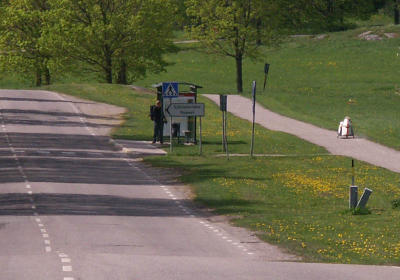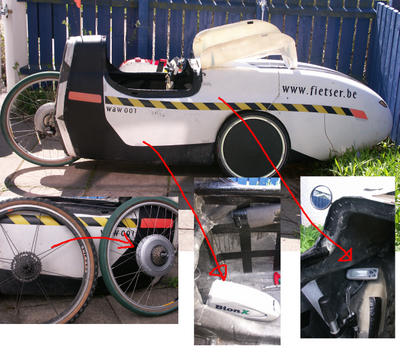- 40% more range by using regeneration -
Introduction
Since the BionX was mounted in the Waw for about six months ago, I wanted to do some kind of test to see how much the most unique feature of the system pays of: the possibility to use the assist engine as a generator charging the battery under braking/slowing down.
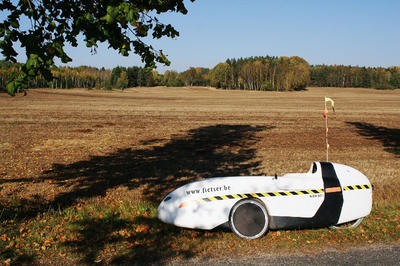 A velomobile such as the Waw are practical yet very efficient machines due to the good aerodynamics. However, up a (steep) hill, the aerodynamics help nothing and the higher weight comes into play. If your riding conditions include a fair amount of uphill riding, an electric assist engine becomes a solution.
A velomobile such as the Waw are practical yet very efficient machines due to the good aerodynamics. However, up a (steep) hill, the aerodynamics help nothing and the higher weight comes into play. If your riding conditions include a fair amount of uphill riding, an electric assist engine becomes a solution.
Convinced by my friend Peter who insisted that I look for a system, I found the BionX on the internet.
It was interesting for a few reasons:
- it could be mounted easily on any bicycle and also in my velomobile
- it was a light system, adding only 8 kg so interfering little when cycling
- possibility to choose the level of assist without the jerkyness of an on-off like behaviour of other systems
- most prominently, the regenerative braking: applying the brakes gently activates the assist engine as a generator, charging the batteries and hopefully increasing range
A BionX is not cheap, but my experience has already showed that a range of approx. 100km is possible in my area, considerably more than the 30km that the system would do on a regular bicycle. This large increase is at least partly because a velomobile it is easy to ride a lot above 25km/h, the speed when the BionX stops assisting (as by law in Europe). So a big part of the increase is on account of the velomobile. But what is also obvious is that one uses the regenerative braking function much more on a velomobile, both because speeds downhill quickly become more than high enough so that one can use that excesive speed to charge the battery, and because cruising speeds are higher and thus slowing down takes longer time. The big question is: how much difference does this regeneration function - for slow down or braking - really make? (It is also possible to load the battery while during constant riding for e.g. training purposes or while riding with a slower companion - I am NOT talking about this function here!).
To find out, I made a test: riding a fixed course while using the function, and once without regenerative braking.
The course
For this test to be realistic and accurate as possible, I needed to find a suitable course. A round course would have been ideal, but I did not know any in my neighbourhood. There is a fairly calm road with the steepest uphills I know just 5 km from my home, so this would be the road.
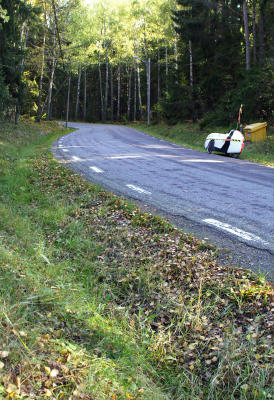 First I thought of riding up and down a short steep bit, keeping the test length as short as possible - draining the battery as fast as possible. However I decided not to do so because it seemed unrealistic (too many u-turns) and perhaps most important, I would not be able to motivate myself to ride up the same road so often. So I took a longer stretch of 1,5 km, so including another steep piece of road (hard to catch on a photograph, see on the right).
First I thought of riding up and down a short steep bit, keeping the test length as short as possible - draining the battery as fast as possible. However I decided not to do so because it seemed unrealistic (too many u-turns) and perhaps most important, I would not be able to motivate myself to ride up the same road so often. So I took a longer stretch of 1,5 km, so including another steep piece of road (hard to catch on a photograph, see on the right).
Test conditions
First I rode the course with regenerative braking, the afternoon of 29 september. 8th october in the morning I had time to do it without. In between the Waw rode only 90km, so it should be in the same condition.
The battery was topped-off, i.e. a fully charged battery was charged again the morning of the test for approx another 30 min, assuring that they were really full. Weather was the similar.
I guess that I pedal about 150W (a bit more uphill) and I use assist level 3 always - 100% assist, as I would do when I commute. Doing the course many times should level out small differences in power. Between the days may be more subjective, although I also tried to keep the speeds constant at certain check points, especially the moment when I start using the assist (by dropping under 25km/h) and when I start regenerating.
 The map shows the testroad between the black dots. The red lines besides the road show the parts I used the assist function (always level 3 - 100%). The blue show the stretches I used the regeneration braking function. The piece of road is approx. 1470m, a run back and forth is double. On such a run, assist is used approx 850m, regeneration braking approx. 600m. Speed upphill would drop to 13km/h on the steepest part, which is approx half of those 850m. On the downhill, speed was approx 10km/h slower using regenerative braking, which I engaged always at 35km/h. I did not regenerate till standstill, but applied the brakes for the turning points, where I usually made a full stop. So there some simulation for stop and go traffic too. Full topographic data would of course be even more intresting, do not have that though (there are some height lines on the map, don´t know the differential between them).
The map shows the testroad between the black dots. The red lines besides the road show the parts I used the assist function (always level 3 - 100%). The blue show the stretches I used the regeneration braking function. The piece of road is approx. 1470m, a run back and forth is double. On such a run, assist is used approx 850m, regeneration braking approx. 600m. Speed upphill would drop to 13km/h on the steepest part, which is approx half of those 850m. On the downhill, speed was approx 10km/h slower using regenerative braking, which I engaged always at 35km/h. I did not regenerate till standstill, but applied the brakes for the turning points, where I usually made a full stop. So there some simulation for stop and go traffic too. Full topographic data would of course be even more intresting, do not have that though (there are some height lines on the map, don´t know the differential between them).
The results
Average speed without using the regenerative braking was 26,7km/h, with regen 25,6 km/h. So the difference here is small. If you think these averages are low, just remember that mere mortals on a regular bike walk up these slopes, probably averaging under 10km/h if they would do the whole course...
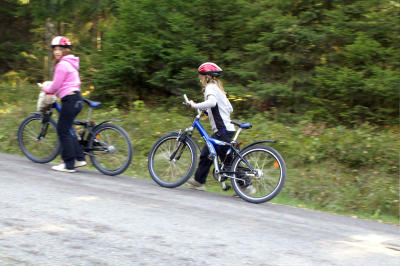 The range with regenerative braking was 63km untill the battery indicator said the battery was empty, 44km without. All distances and speeds come from the BionX screen which I find having very good precision, even if it is not possible to calibrate. Since I use a very high tire on the rear wheel, actual distances and speeds might be a bit higher.
The range with regenerative braking was 63km untill the battery indicator said the battery was empty, 44km without. All distances and speeds come from the BionX screen which I find having very good precision, even if it is not possible to calibrate. Since I use a very high tire on the rear wheel, actual distances and speeds might be a bit higher.
Assuming a precision of 1km for the battery indicator and taking as reference the distance when the battery icon showed empty, the increase in range is 43% +- 5% because of using the regenerative braking function. Continuing cycling after the battery indicator said it was empty, I hoped to meet the point when the system would shut itself down, using that as a second verification point. However this did not happen.
When I set out the first time, in my optimism, I though this test would be done within 40km. After 63 km the battery icon showed empty, which was a nice surprise. Then I thought another 10km would make the system shut off completely. But it did not happen. By this time it was stinking dark if I may say so - didn't plan that - and to my sore legs complaint I could continue another 26km on the "empty" battery before the assist level became much weaker and the system started to jerk. 89km. That was it I said to myself and continued home. The assist would continue to work, just with reduced power. So there is no automatic shut off then.
On the second run without regen braking, the jerky behaviour started at approx 56 km, only 12km after the battery icon showed empty. This could be explained that a depleted battery is much more receptive to the charging because of the higher voltage difference - thus explaining the large difference. Take this distance when jerky behaviour shows up as a reference and the increase in range is almost 60%.
In this test I used 100% assist all the time. Using level 2 of 50% would probably make the increase in range much larger again. But then one wouldn't have much so much help either of course.
Conclusion
I think this test was very practical and realistic. Of course different people, a different course and a different vehicle can change the results a lot. Nevertheless, it is clear to me the regeneration braking function is not a gimmick but makes a real difference and since the test I have been using it more conciously and expect ranges far over 100km now for my area. The bionX + velomobile combination is truly symbiotic. The velomobile becomes more usefull in a more varied terrain and so widens the areas where it can be used - the assist becomes more applicable because of the efficiency of the velomobile. Especially with the regenerative braking, I think it is more suitable to describe the whole as a human-electric hybrid system where human and electic power live in a symbiotic relation, then to simply speak of an assist.
Perhaps this time is a good time to list my general evaluation of the BionX.
Pro:
-A light system that adds only approx 8kg, only a minimal reduction in human power performance when assist is not used (or above 25km/h).
- Easy to install, seems reliable (good quality/finish).
- Possibility to choose level of assist, assist is gradual and non intrusive to the cycling experience
- Regenerative braking fuction really pays off in a velomobile and gives an extra dimension in proactive (safe and efficient) driving
- Futher possibility to use the motor as a generator in 4 levels, so charging the battery (e.g. riding in a slow group, for training, choosing speed on long slopes).
- relative quick charging - 3 to 4 hours
- Large range should cover all commuting needs - battery life should last a fair part of most velomobile lives (500 charges x 100km = 50000km)
- Good details: speed and odometer, screen lighting, battery lock and alarm are very usefull functions
- Good investment if used well
Con:
- Rather expensive in undiscriminating comparison with other systems
- vibrations in regeneration mode can become disturbing under 25km/h
- Some numbers in the screen are not clear - defective screen
- rear wheel not spoked properly at delivery
- assist shuts off rather abruptly above 25km/h (but inherent to the law requirements)
- not a high torque engine (if you want that)
- Alarm sound is very quiet, keeps one from riding the bionX, not from riding the bike (does not replace a lock).
- 0,1Nm loss because of the brushless engine - some loss but not much
I would like to thank Peter for bringing some food and drink when the test lasted much longer than expected, and for encouraging me that I should try out and experminent with assist systems. Or should I say hybrid system? Answering the original question of this blog, I would answer: it very well could be!
 I have ridden now and then, shorter distances. With a studded MTB rear tire, traction is sufficient to make riding possible in snow and ice, although within limits. The assist is a welcome help to plough through the parts where the roads have not been ploughed from fresh snow. Much depends on the quality of the snow, some snow gives hardly any (rolling) resistance, other types are so mucky that only a few centimetres is enough to seriously hinder progress.
I have ridden now and then, shorter distances. With a studded MTB rear tire, traction is sufficient to make riding possible in snow and ice, although within limits. The assist is a welcome help to plough through the parts where the roads have not been ploughed from fresh snow. Much depends on the quality of the snow, some snow gives hardly any (rolling) resistance, other types are so mucky that only a few centimetres is enough to seriously hinder progress. 





